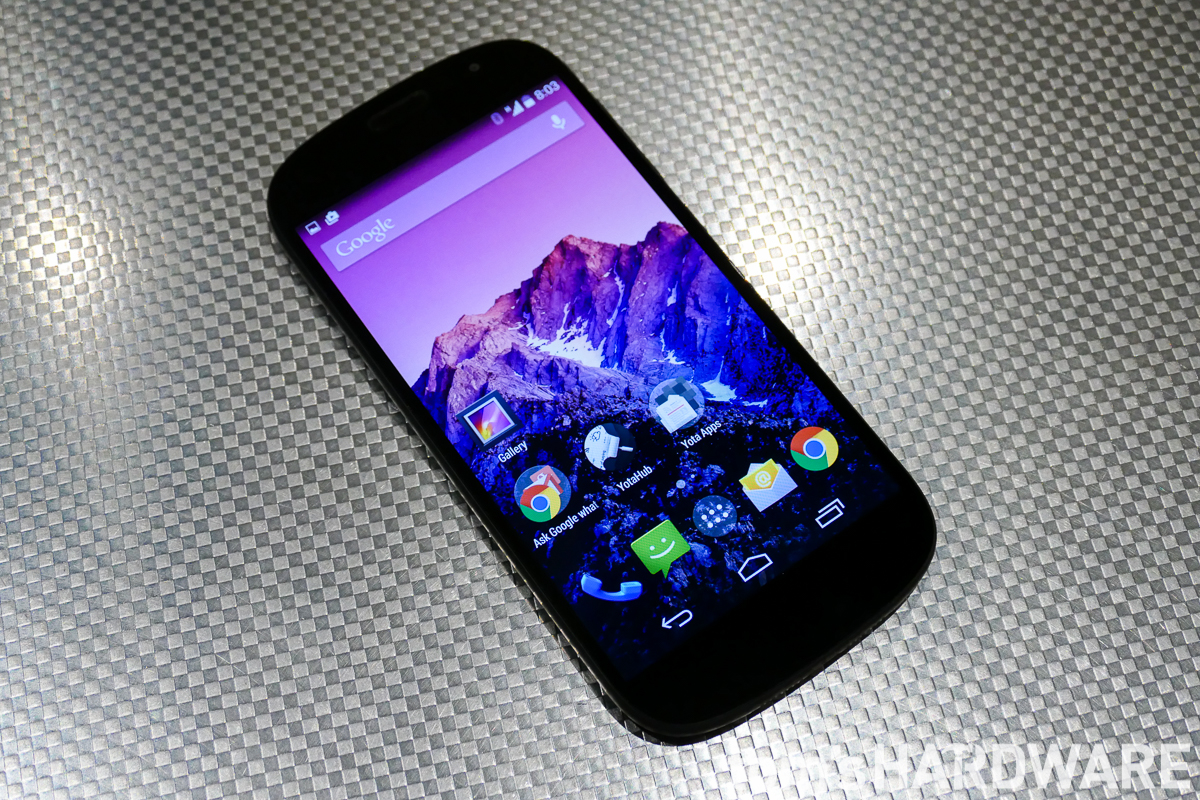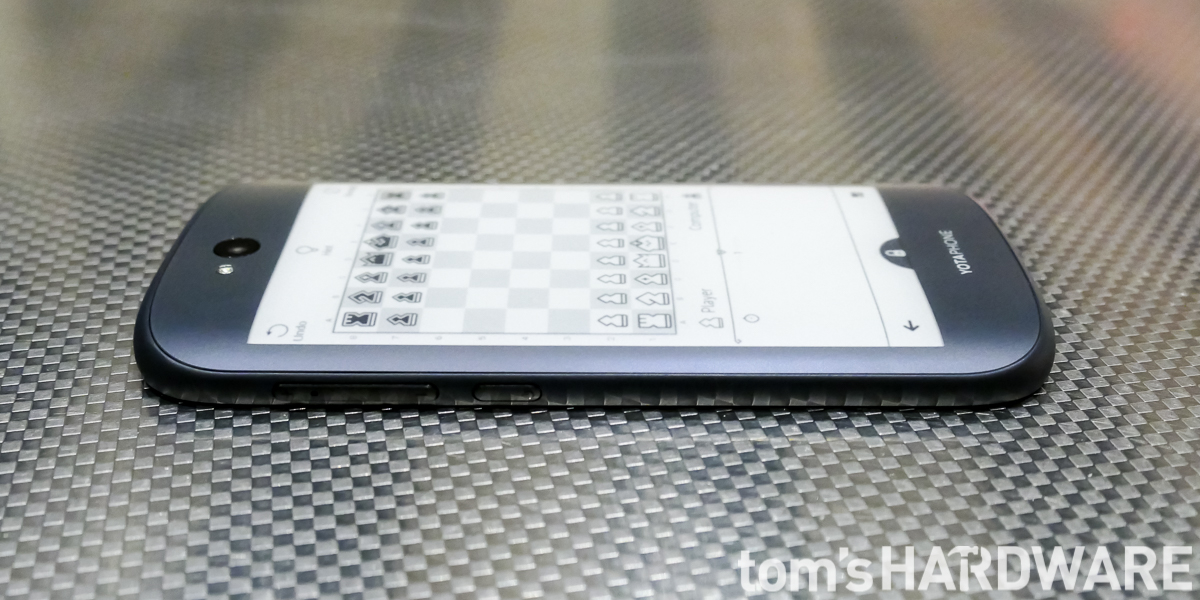YotaPhone 2: A Smartphone With A Secondary E-Ink Screen, Hands-On
The YotaPhone 2 has a dual-screen personality: energetic and colorful when facing you, but passive and gray when its back is turned. Is the secondary e-ink screen just a gimmick, or does it actually improve the smartphone experience?
LG's G Flex 2 was the only flagship phone announced at CES 2015; however, this was a blessing in disguise, because it allowed us to check out some companies and phones that we may have perhaps overlooked, such as ones by Saygus and Yota Devices. Founded in Moscow, Yota was showing off the intriguing YotaPhone 2. Claiming to be the "world's first double screen smartphone," it has a regular AMOLED LCD display on one side and a low-power e-ink display on the other.
Tech Specs
| SoC | Qualcomm Snapdragon 800 (MSM8974AA) |
|---|---|
| CPU | Qualcomm Krait 400 (4 Core) @ 2.26 GHz |
| GPU | Qualcomm Adreno 330 @ 450 MHz |
| Memory | 2 GB LPDDR3 |
| Display | FRONT: 5.0-inch AMOLED @ 1920 x 1080 (442 ppi) with Gorilla Glass 3REAR: 4.7-inch E-Ink @ 960 x 540 (235 ppi) 16-level gray scale with Gorilla Glass 3 |
| Storage | 32 GB |
| Battery | 2,500 mAh (non-removable) with wireless charging |
| Cameras | Front: 2.1 MPRear: 8 MP AF, LED flash |
| Audio | Mono |
| Expansion Ports | microUSB 2.0 |
| Connectivity | Wi-Fi 802.11a/b/g/n/ac, Bluetooth 4.0 LE, NFCCat 4 LTE (bands 3/7/20) |
| Dimensions | 144.9 x 69.4 x 8.95 mm |
| Weight | 145 g |
| Operating System | Android 4.4, KitKat |
The YotaPhone 2 comes with decent hardware, although considering its premium price, we expected better cameras. The Snapdragon 800 SoC is hardly cutting edge either, but it still provides a decent level of performance and is more energy efficient than its higher-clocked siblings.
We had a positive first impression of the YotaPhone 2. It's an attractive (though a little boring looking), premium-feeling phone. We found this a little surprising, as the original YotaPhone, launched in select markets in 2013, didn't receive rave reviews. While its secondary e-ink display was innovative, Yota's first dual-screen phone was under-powered, and its software was half-baked.
The YotaPhone 2, however, is a big improvement. The integration of the secondary e-ink display is well thought out, and Yota's software features utilize it well, improving the smartphone experience beyond just simple power savings. For example, customizable dashboards can be created for displaying relevant information on the back of the phone. This allows you to check the weather, stock prices, Twitter updates, or important emails without having to wake the phone and use the power-draining main display.
Yota has also integrated "YotaSnap" into the OS, which allows you to take a screenshot of anything on the main display and send it to the e-ink screen. This is ideal for displaying a boarding pass with a QR code; you can keep it on the phone's e-ink screen while you're checking in without killing the phone's battery.
(Correction: We refer to the screen as IPS in the video, when it's actually an AMOLED display.)
Although Yota Devices is originally a Russian company, it has been expanding globally, opening offices in Canada, China, Finland, Germany, Singapore, and the U.S. Perhaps the former Nokia employees now working in the R&D office in Finland contributed to the high-quality look and feel of the YotaPhone 2.
Get Tom's Hardware's best news and in-depth reviews, straight to your inbox.
We had the opportunity to speak with Yota Devices' CEO, Vlad Martynov, who discussed the YotaPhone 2, the benefits of having a secondary display, and the company's 2015 plans for the North American market.
During our interview, he said that the YotaPhone 2 would be coming to North America, but he couldn't share any details yet. However, Matthew Kelly, Yota Devices Managing Director, Americas did confirm later during CES that it's definitely coming to one of the big four U.S. carriers. Unfortunately, there is no news about Canadian availability yet. While its price in Euros approximately translates to an eye-watering $850, the price should drop once it arrives here to compete with other premium smartphones.
The YotaPhone 2 is a unique and potentially ground-breaking device. While the phone itself appears very well-made, some of its hardware specs are merely average. It's the addition of the e-ink display that makes all the difference. What's more, Yota hasn't just slapped a second screen on the back and called it a day. Yota has clearly thought out the use cases and benefits of having this secondary display and has built software around it to maximize its potential.
We're looking forward to testing out the YotaPhone 2 for a longer period. Even if this phone doesn't live up to our expectations, the idea of an e-ink secondary display is something we'd like to see on more phones going forward, whether they be from Yota or under license from them by someone else. The YotaPhone 2 is available in selected European and Asian markets, and can be ordered on the Yota site. Once it's available in North America, we'll be sure to update you.
Follow Alex Davies @alexbdavies. Follow us @tomshardware, on Facebook and on Google+.
-
everlast66 YotaPhone ?Reply
Yuk, I was hoping for a DotaPhone, have to start reading more carefully :) -
smeezekitty I would really like to see a full touch matrix on the back screen. Of course the software would have to be well designed to not accidentally mess something up. But as it is, it seems too staticReply -
virtualban e-ink secondary display, and dual camera on the same side, is what I have always wanted. One is out, and one needs more push as the dual cameras are typically separated by 2-3 centimeters instead of typical eye distance. 3D may be not at top quality at this stage of technology, but, without needing to display those photos and videos in stereo on the phone itself, just store them, as that is indoubtly the future, holographics or direct nerve stimulation or whatever, why not snap a stereo photo instead of a regular?Reply
Yes, I understand, dual display and dual camera are extra costs, which the mainstream phones won't need, but there could be exceptions, such as Yota phone.


